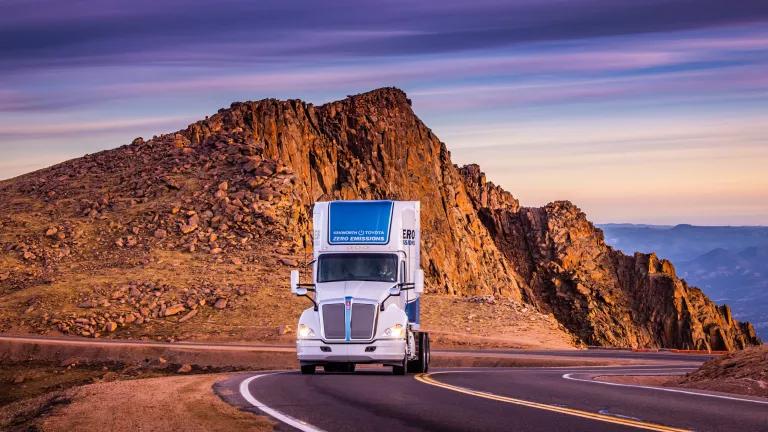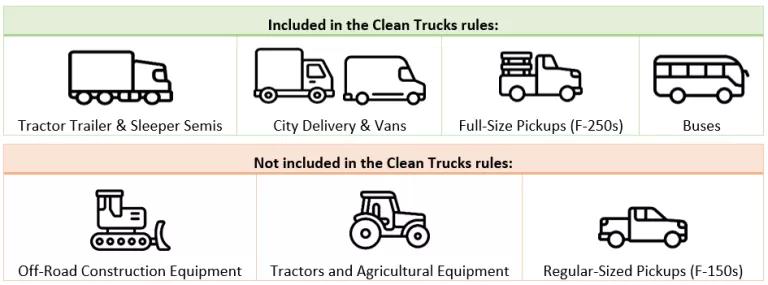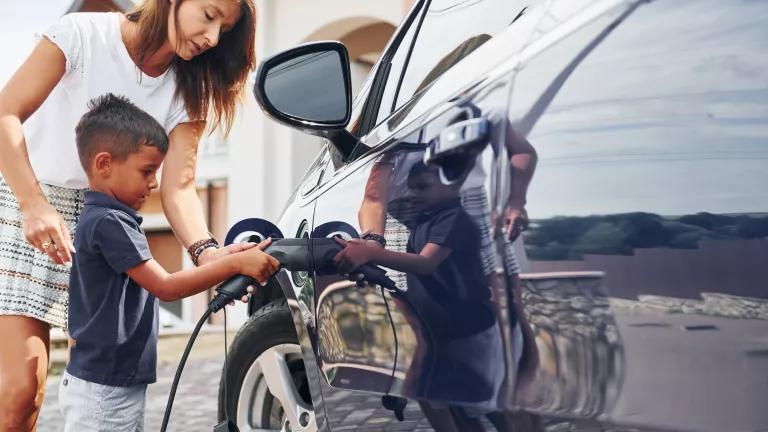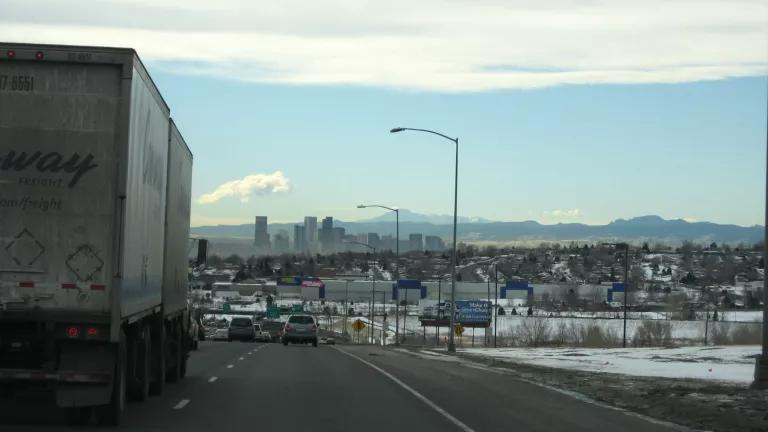Why Colorado Needs Clean Trucks
Colorado is poised to see cleaner air, reduced emissions, and a thriving market for zero-emission trucks with two important rules in 2023: Advanced Clean Trucks and Low-NOx Trucks.

A Zero-Emission Sleeper Semi trucking up Pikes Peak in Colorado Springs.
Colorado is poised to see cleaner air, reduced emissions, and a thriving market for zero-emission trucks with two important rules in 2023: Advanced Clean Trucks and Low-NOx Trucks. The rules will safeguard public health, protect disproportionately impacted communities, and help Colorado reach its climate goals, all while bringing economic benefits to business owners and residents.
Heavy-duty trucks are a huge contributor to pollution and climate change, contributing 59% of toxic NOx emissions and 55% of particulate matter air pollution, despite only representing 10% of vehicles in Colorado. The technology is available to move to clean, zero-emission trucks, and we need these rules now to realize all the benefits. With a stakeholder process starting this fall and continuing through the winter, it’s important to know the facts about the two rules. Read on to learn all about the rules and why Colorado needs clean trucks.
Advanced Clean Trucks and Low-NOx rules are good for our health, good for the planet, and good for our economy
Advanced Clean Trucks rule: Sales Requirement for Zero-Emission Trucks
What are “Clean Trucks?” A truck, bus, or van is considered “clean” when it has zero tailpipe emissions. For the ACT rule, zero-emission vehicles (ZEVs) include battery-electric vehicles, plug-in hybrid electric vehicles, and hydrogen fuel cell electric vehicles. Just like the name implies, these vehicles are clean: they have no tailpipe greenhouse gas emissions and no combustion-related air pollution.
The Advanced Clean Trucks rule will require manufacturers to sell zero-emission medium- and heavy-duty vehicles as a percentage of their annual sales in Colorado starting in model year 2027. The percentages will start off small and gradually ramp up over time. This way, manufacturers have time and flexibility to sell the best ZEVs, and purchasers have a thriving market with a variety of affordable models of clean trucks and buses. The ACT rule does not require any fleet owner to purchase a zero-emission vehicle. However, with state and federal tax credits, by 2027 nearly all classes of vehicle will have a lower total-cost of ownership than their diesel counterparts.
Low-NOx Rule: Stricter Emissions Standards for Trucks
The Low-NOx rule will ensure that new heavy-duty trucks in Colorado will meet higher standards to reduce harmful NOx emissions. Diesel trucks are responsible for a significant amount of NOx and particulate pollution in Colorado; this rule will ensure these dirty trucks do not continue impacting the air we breathe by reducing NOx emissions by up to 12,100 metric tons by 2050. The rule requires manufacturers to cut the emissions of diesel trucks by 90% by 2027, update engine testing and durability, and extend engine warranties to ensure that harmful emissions are regulated in the vehicles being sold in Colorado.
Both rules apply to manufactures of medium- and heavy-duty vehicles, which are vehicles over 8,501 pounds.

The Clean Trucks rules work together to fight air pollution and protect the environment. The advanced clean truck rule seeks to address the medium and long-term impacts of heavy-duty vehicles by transitioning them gradually to zero-emission. The low-NOx rule works in tandem to address the short- and medium-term air pollution brought by diesel trucks by cutting existing tailpipe emissions. Together, these rules will clean up our air and protect our health right now and ensure a clean, healthy, green future.
Clean Trucks are Good for Our Health
Advanced Clean Trucks and Low-NOx truck rules would have transformative positive health impacts. Zero-emission vehicles are free from the two main pollutants driving Colorado’s serious air pollution problem: ozone pollution from NOx emissions and ultrafine particulate matter, called PM 2.5. Diesel trucks and buses, though, are big polluters. Despite making up only 10% of vehicles in Colorado, medium- and heavy-duty vehicles contribute to 59% of NOx emissions – which create ozone pollution – and 55% of PM 2.5 pollution.
Zero-emission trucks can protect Coloradans from the serious health impacts of air pollution, including asthma, lung infections, cardiovascular diseases, lung cancer, reproductive harm, and even premature deaths. The American Lung Association estimated that, by 2050, the ACT and Low-NOx truck rules would prevent 18,520 asthma attacks and 89,000 lost days of work. Incredibly, clean trucks could save 485 Coloradans from premature deaths caused by air pollution. Air pollution-related health impacts are expensive. By 2050, the clean truck rules would save $5.4 billion in avoided health costs across the state, which translates to savings in your wallet.
The clean truck rules will also improve health equity and environmental justice. Communities of color and low-income communities in Colorado are more likely to live near major truck routes, ports, or warehouses. People of color in Colorado experience 64% more PM 2.5 pollution than the average Coloradan. In addition, areas with high medium- and heavy-duty traffic have severe carcinogenic impacts due to the long-term exposure to pollutants. By ensuring that the trucks passing through disproportionately impacted communities in Colorado are clean and free of dirty diesel, the rules will protect the health of these communities.
Clean Trucks are Good for the Environment
In addition to air pollution, trucks also emit greenhouse gases that contribute to climate change. Transportation is the largest source of greenhouse gas emissions in the state, and medium- and heavy-duty vehicles contribute disproportionately – they are responsible for a quarter of transportation emissions despite only making up 10% of vehicles. Along with contributing to Colorado’s historic wildfires, drought, extreme weather events, and threats to our fragile alpine ecosystems and important crops, climate change drives socioeconomic and racial disparities.
Zero-emission vehicles have no tailpipe emissions, which means that they won’t emit greenhouse gases that contribute to climate change. These rules help reduce transportation emissions in Colorado by 3.3 to 4.4 million metric tons, and would also help Colorado remain in line with laws that require the state to reduce emissions by 90% by 2050. Since zero-emission vehicles are more efficient than fossil-powered vehicles, they contribute fewer greenhouse gas emissions, even with a fossil-fuel based electric grid. By 2040, Colorado’s grid is expected to be powered by 100% renewable energy , which means that battery-electric zero-emission trucks will be completely powered by clean, renewable electricity. The ACT rule will accelerate the adoption of zero-emission trucks and buses, allowing us to take advantage of our cleaner grid.
Clean Trucks are Good for Our Economy
The Advanced Clean Truck and Low-NOx rules will spur innovation, jumpstart the market, and offset climate and health-related costs. Altogether, the rules could add an estimated $20.4 Billion in total net societal benefits by 2050, directly improving the lives of Colorado residents. According to analysis by the Colorado Energy Office and the American Lung Association, if enacted next year, by 2050 the economy-wide benefits of the rules would include:
- $5.8 Billion in cumulative net fleet savings, including purchase costs and fuel and maintenance expenses, which accounts for the capital cost to transition the fleet.
- $5.4 Billion in cumulative public health savings from reduced tailpipe emissions.
- 183,440 reduced premature deaths, asthma and ER visits, hospital admissions, and minor cases related to air pollution.
- $13.2 Billion in social costs avoided from greenhouse gas emissions and toxic air pollution.
- $95 Million in annual net utility revenue from electric truck and bus charging.
Colorado is Ready for Clean Trucks
Six states – California, Washington, Oregon, Massachusetts, New York, and New Jersey – have already adopted the clean truck rules. Colorado should be the seventh. While Colorado already has charging infrastructure and hundreds of models of zero-emission trucks and buses, a suite of state and federal funding will help Colorado further drive down costs and prepare for our clean truck future.
Although the owner of a zero-emission truck or bus saves an average of $22,700 over its lifetime, higher upfront costs for some models may be a deterring factor for small business owners or individuals. Federal and state funding are here to help. The recently-passed federal Inflation Reduction Act contains $2.8 billion in federal funding for medium and heavy-duty zero-emission vehicle purchases in the form of grants, tax credits, and rebates, with funding set aside specifically for low-income and disproportionately impacted communities.
Federal funding will further drive down costs and accelerate the build out of supporting infrastructure. The National Electric Vehicle Infrastructure (NEVI) program grants will provide funding to create a charging network across the state. The Inflation Reduction Act will also sets aside a $100,000 tax credit for purchasing and installing chargers, making them even more accessible for businesses and the public.
Colorado state funding is also aimed at making zero-emissions trucks more affordable. Colorado’s clean truck strategy has programs that will invest in clean vehicle incentives and charging infrastructure, which will help small businesses and low- to moderate-income individuals overcome cost barriers and adopt clean trucks.
Clean trucks benefit truck drivers as well. Zero-emission trucks are often quieter, safer, and more maneuverable than diesel-powered trucks.
How You Can Support Clean Trucks in Colorado
The sooner we pass the Clean Trucks rules, the sooner manufacturers can ready production for the electric trucks of the future to meet demand, protect our air quality and health, and curb emissions. Because the rules include a two-year lead time requirement to allow technology and market forces to evolve, if passed in 2023, the first model year the rules would apply to is 2027. We must act promptly to pass the rules in 2023 and fully realize the positive impacts for our state.
Coloradans are ready to breathe healthier air, slow the impacts of climate change, and ensure a clean future for our state.
Follow along with the rulemaking process at Colorado’s clean truck website.
Want to learn more? Check out our fact sheet for the details of the two rules.




